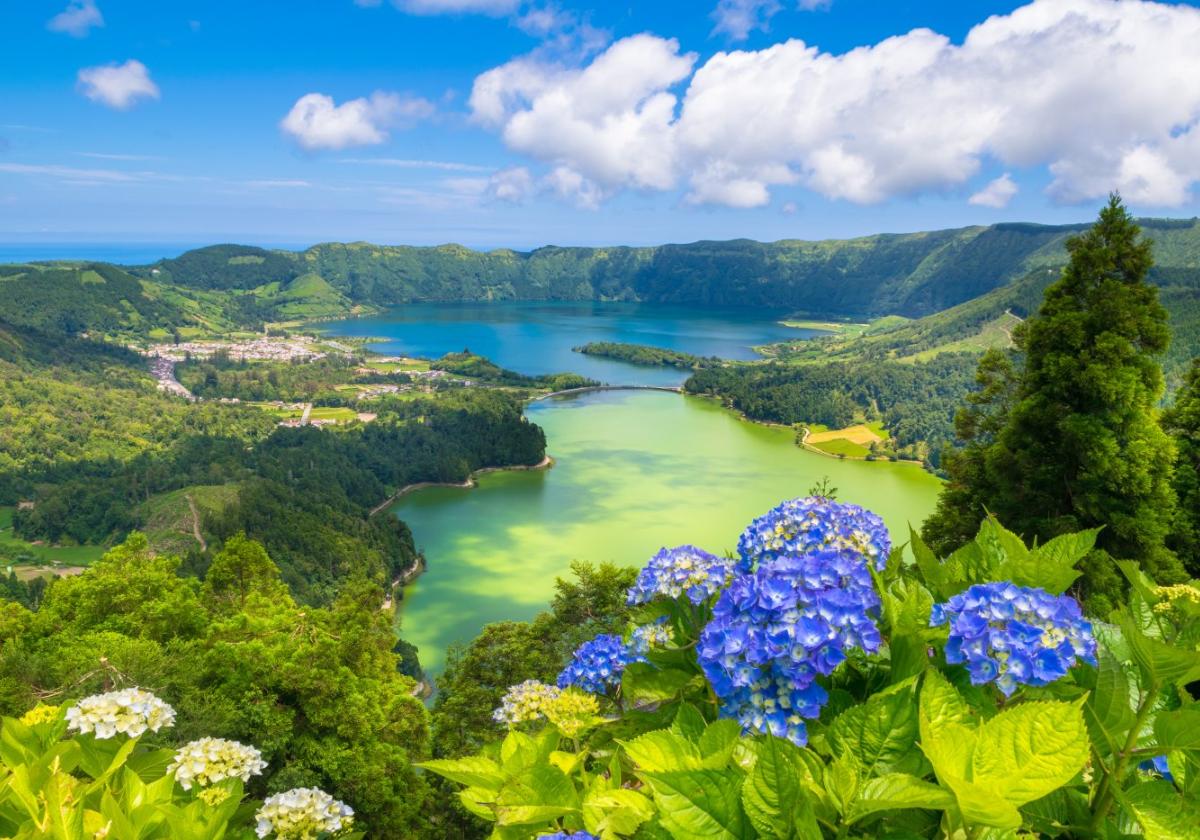

Sections
Highlight

Harry Lawley
Friday, 28 March 2025, 12:28
Athousand miles from the European mainland and located at the junction of three tectonic plates, the Azores are a collection of nine volcanic islands, each boasting dramatic coastlines and wild countryside. The subtropical climate means that the islands' beautiful landscapes can be enjoyed all year round, the daytime temperature rarely dropping below double figures, even in the winter.
Most visits to this Portuguese outpost begin in São Miguel where almost all international flights land. This is where the islands' most populous city is located, Ponta Delgada. Home to an ancient fort and cobbled streets with cosy sailor bars, Ponta Delgada is a charming base to explore the island's natural attractions.
Heading west past the city's busy port, the road leads through lush green pastures, evocative of England's Devon or Cornwall, a sea of pink and blue hydrangeas on the right, and the vast Atlantic Ocean ahead.
On the ascent to Sete Cidades, the vegetation appears more tropical as the clouds temporarily block the view. Then the lakes appear. Two crater lakes, one emerald green, the other cobalt blue, separated by steep slopes from the crashing Atlantic. In the small village of Sete Cidades, visitors can rent canoes or bikes to explore the hidden corners of this earthly paradise.
Sete Cidades is one of many volcanic lakes on the archipelago and all visitors should make their way to Furnas where bubbling thermal springs and mud pools surround the lake's warm waters. Enjoy a massage or a swim in the relaxing outdoor spa of Terra Nostra, surrounded by beautiful botanic gardens.
After a hearty lunch of cocido das furnas, a stew cooked underground using geothermal heat, the next stop should be the beach. Praia de Santa Bárbara is a kilometre-long stretch of black sand and is famous for its exciting surf and luxurious ecohotel. This is the place to watch the sunset over the Atlantic while enjoying a glass of one of the islands' aromatic wines.
From São Miguel, take a short flight to another of the archipelago's hidden gems, Faial. While exploring the island's main settlement, Horta, grab a drink at Peter Café Sport. The famous sailor's tavern, is popular with transatlantic yachters whose flags and gifts adorn the walls.
Wherever you go on the island, the looming presence of Mount Pico leaves a menacing impression. The island of Pico is separated from Faial by a narrow channel where whale watching tours search for the animals that once were hunted by the islanders.
Norberto, a former whaler, organises boat trips to see the sperm whales and dolphins that are residents of these waters. His extensive knowledge and confidence in the animals' presence contribute to the exhilarating excursion.
Travelling around the island of Pico, visitors should make a pitstop at one of the vineyards whose lava stone walls line the narrow roads. The volcanic soil provides the perfect conditions for the verdelho grape to be cultivated and at the Unesco-protected wineries, oenophiles can try the local variety.
The more adventurous can leave the wine for later and take on the challenging nine-hour hike to Mount Pico's summit. At 2,351 metres above sea level, it is Portugal's highest peak, and the route takes you through fields of roaming cattle before revealing jaw-dropping views of the Atlantic and neighbouring islands.
Before returning to São Miguel, it is important to find out more about the islands' volcanic geology. The last significant eruption in the archipelago took place at Capelinhos on Faial in 1957. Destroying 300 houses and lasting 13 months, the catastrophic events led to the evacuation of 2,000 people, many of whom emigrated to the United States.
Today, tourists can learn about the eruption at the visitor centre and observe the eerie Martian landscape from a trail that runs to the summit.
Back in São Miguel, make sure to try the island's culinary highlight, the Bolo Lêvedo. Similar to an English muffin, this gastronomic speciality is a staple in the island's many bakeries and is served with sweet or savoury fillings.
The final stop of this island-hopping itinerary is Vila Franco do Campo, a small town located on São Miguel's sunny south coast. The fishing port, which was once the Azores' capital, is a popular summer holiday destination for the islanders.
Many take a boat to the small islet that offers a perfect base for snorkellers. Below the choppy waters, another world presents itself, a vibrant seabed brimming with marine life.
The holiday may be over but the memories will last for a lifetime. The photos of jumping dolphins and azure waters will cast your mind back to this mid-Atlantic refuge. Recollections of the soothing waters of the islands' hot springs will help you escape the bleak British winter.
The best thing though is that the Portuguese paradise, Europe's Hawaii, is only a three-hour flight from Madrid or Barcelona or a four-hour flight from London.
Noticia Patrocinada
Publicidad
Fernando Morales y Álex Sánchez
J. Gómez Peña y Gonzalo de las Heras (gráfico)
Encarni Hinojosa | Málaga, Encarni Hinojosa y Antonio M. Romero
Esta funcionalidad es exclusiva para registrados.
Reporta un error en esta noticia

Debido a un error no hemos podido dar de alta tu suscripción.
Por favor, ponte en contacto con Atención al Cliente.

¡Bienvenido a SURINENGLISH!

Tu suscripción con Google se ha realizado correctamente, pero ya tenías otra suscripción activa en SURINENGLISH.
Déjanos tus datos y nos pondremos en contacto contigo para analizar tu caso

¡Tu suscripción con Google se ha realizado correctamente!
La compra se ha asociado al siguiente email
Comentar es una ventaja exclusiva para registrados
¿Ya eres registrado?
Inicia sesiónNecesitas ser suscriptor para poder votar.